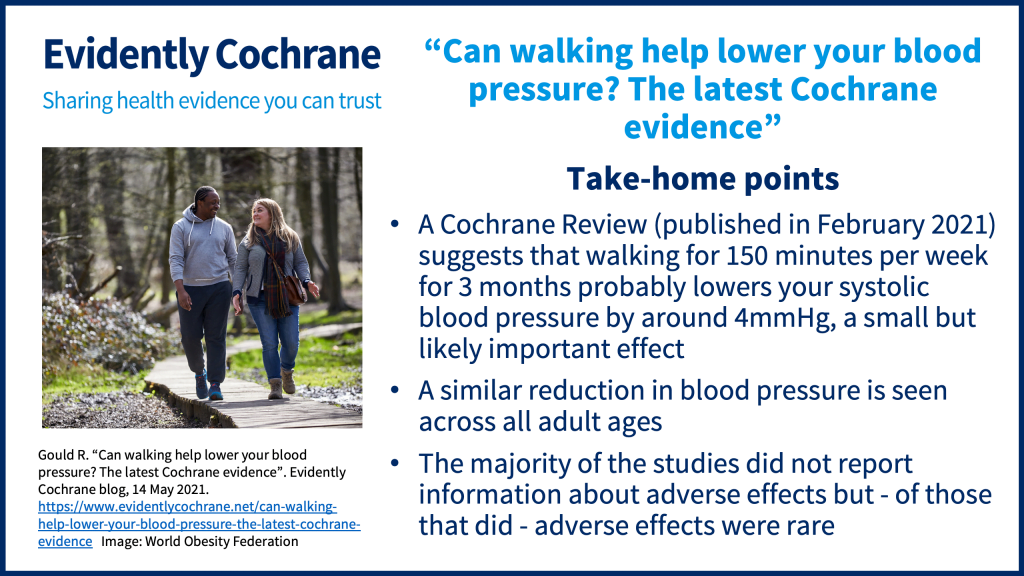In this blog for people with normal or high blood pressure (hypertension), Dr Rebecca Gould, Cochrane UK Fellow and Sport and Exercise Medicine Registrar, looks at the latest Cochrane evidenceCochrane Reviews are systematic reviews. In systematic reviews we search for and summarize studies that answer a specific research question (e.g. is paracetamol effective and safe for treating back pain?). The studies are identified, assessed, and summarized by using a systematic and predefined approach. They inform recommendations for healthcare and research. on walking for lowering blood pressure and explores the role of walking in the prevention and treatmentSomething done with the aim of improving health or relieving suffering. For example, medicines, surgery, psychological and physical therapies, diet and exercise changes. of high blood pressure. (Featured image: World Obesity Federation).
Page last checked 3 July 2023

When I worked as a GP, I met many people with, or at riskA way of expressing the chance of an event taking place, expressed as the number of events divided by the total number of observations or people. It can be stated as ‘the chance of falling were one in four’ (1/4 = 25%). This measure is good no matter the incidence of events i.e. common or infrequent. of developing, high blood pressure. It is common, affecting over 50% of people aged over 60 years, and important to treat, as it is a risk factor for a number of other conditions including heart failure, coronary artery disease, stroke, chronicA health condition marked by long duration, by frequent recurrence over a long time, and often by slowly progressing seriousness. For example, rheumatoid arthritis. kidney disease and vascular dementia. Reducing high blood pressure helps reduce these health risks.
For those with high blood pressure, starting blood pressure lowering medication should be a shared decision between them and their healthcare professional and take into account factors such as how much blood pressure is raised, the presence of other medical conditions, and long-term risk of cardiovascular disease.
Lifestyle advice is recommended for everyone with high blood pressure, and this was something I found people were often keen to discuss. Helpful changes that can be made include reducing alcohol intake (if excessive), reducing salt intake, avoiding excessive consumption of caffeine-rich products and increasing physical activity. I would often spend a bit more time discussing physical activity as it has many other health benefits (reduces the risk of developing type 2 diabetes, heart disease, joint pain and certain types of cancer and improves quality of life, sleep and stress levels).
Walking was commonly chosen as a way of increasing physical activity as most people are able to do it, it is relatively easy to fit around daily life, and does not cost much (if anything). When I was having these conversations, there was no clear evidence on the ideal amount of walking for people with high blood pressure, so my advice would be to aim for 150 minutes of moderate-intensity physical activity per week (in keeping with UK physical activity guidelines). For people who are unable to do that much, it is important to remember that some physical activity is better than none, and every minute counts. The definition of ‘moderate-intensity’ can vary, but the UK physical guidelines use the ‘talk test’ for moderate intensity physical activity – your breathing is increased but you can still talk.
Cochrane evidence on walking to reduce blood pressure
A new Cochrane Review, published in 2021, has looked at the effect of walking on blood pressure. The authors looked at studies in adults who had normal, or high, blood pressure where walking programmes were compared to no interventionA treatment, procedure or programme of health care that has the potential to change the course of events of a healthcare condition. Examples include a drug, surgery, exercise or counselling. . They found 73 studies with 5763 participants that met their inclusion criteria. The walking programmes used in the studies varied, but they mainly took place at people’s home or in the community, for example walking on a treadmill or walking outside. The walking programmes on average took place over 3 months and, in most studies, people walked for 20 to 40 minutes, at a moderate intensity, three to five times a week (average walking time 153 minutes per week). The walking programmes were usually supervised.
The authors found that walking for approximately 150 minutes per week for 3 months probably reduces systolic blood pressure by around 4mmHg. This reduction is smaller than the reduction seen with medication but is still important, especially when you consider that physical activity has lots of other health benefits. For comparison, a Cochrane Review looking at the effects of medication in people with high blood pressure found that ACE inhibitors and calcium channel blockers (two commonly prescribed types of blood pressure medication) reduced systolic blood pressure by approximately 16mmHg and 9mmHg respectively.
When looking at people by age, a similar reduction in systolic blood pressure was found across all age ranges (there was moderate-certaintyThe certainty (or quality) of evidence is the extent to which we can be confident that what the research tells us about a particular treatment effect is likely to be accurate. Concerns about factors such as bias can reduce the certainty of the evidence. Evidence may be of high certainty; moderate certainty; low certainty or very-low certainty. Cochrane has adopted the GRADE approach (Grading of Recommendations Assessment, Development and Evaluation) for assessing certainty (or quality) of evidence. Find out more here: https://training.cochrane.org/grade-approach evidence for those under 40 years old, and low-certainty evidence in those aged over 41 years). This reduction was seen both in people who had normal blood pressure, and those with high blood pressure. The authors also found walking may reduce diastolic blood pressure and heart rateThe speed or frequency of occurrence of an event, usually expressed with respect to time. For instance, a mortality rate might be the number of deaths per year, per 100,000 people..
Walking also seems to be relatively safe, only 21 of the 73 included studies recorded adverse events, but in these 21 studies only eight adverse events were reported, 5 of which were knee injuries. Unfortunately, few studies followed participants after the walking programme ended, so the longer term effects of walking on blood pressure are uncertain.
Resources for people wanting to walk more
If you are interested in walking a bit more to help lower your blood pressure, some helpful resources can be found below:
- One You Active 10 Walk Tracker app – this free app from Public Health England tracks your walking, helps you set goals and monitor your progress over time.
- walkingforhealth.org.uk – run by The Ramblers charity, Walking for Health is a network of health walks – group walks open to everyone and led by specially-trained volunteers.
Join in the conversation on Twitter with @CochraneUK and @DrRebeccaGould or leave a comment on the blog.
Please note, we cannot give medical advice and do not publish comments that link to individual pages requesting donations or to commercial sites, or appear to endorse commercial products. We welcome diverse views and encourage discussion but we ask that comments are respectful and reserve the right to not publish any we consider offensive. Cochrane UK does not fact check – or endorse – readers’ comments, including any treatments mentioned.



[…] 2021, a Cochrane review was published in evidentlycochrane.net.The results concluded that walking for 150 minutes per week for three months could reduce your […]